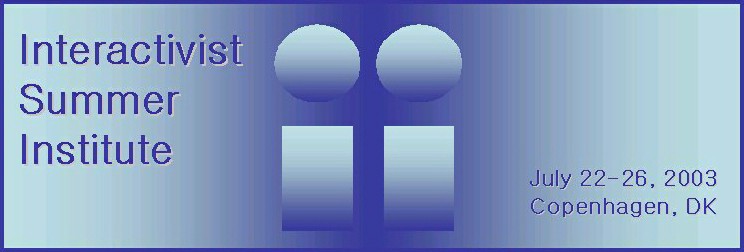
Interactivist Summer Institute
July 22 - 26, 2003
Copenhagen
Stripping the consciousness: Is our cognitive system enough to explain for the phenomenon?
Marek Dobes
Institute of Social Sciences, Slovak Academy of Sciences, Slovak Republic
Extended abstract
There is ongoing debate in cognitive science about the nature of consciousness experience. Based on empirical evidence from other researches, this paper presents aggregate hypothesis on what can consciousness mean in terms of our cognitive system.
Recent research of conscious experience of visual stimuli (Crick, Koch, 1995, Rees, Kreiman, Koch, 2002) implies that during processing of optical signals from environment relatively simple “computations” take place in the area V1. This activity does not correlate with conscious experience. We find correlation first in higher areas (V5) where also “computations” are more complex and therefore have to involve (activate) more neurones. According to Greenfield (2000) conscious experience starts when a group of neurones starts “recruiting” other neurones. Intensity of experience then depends on how successful this spread of activation is. These findings put together imply that conscious experience correlates with a complexity of stimuli which in physiological terms means higher number of simultaneously active neurones. This hypothesis is supported with a well-known fact that above all complex, new or unusual stimuli enter consciousness (Baars, McGovern, 1998). Thus consciousness would be but an expression of higher demands put on cognitive system. Demands that are not determined by any mystical process but cyto-architecture of brain areas and intensity and frequency of electrical stimuli in brain.
Regarding relation between conscious and unconscious processing we could then use a metaphor of gradual “tuning” of a cognitive system. When new information enters, system is out of tune – its “noise” includes many neurones and therefore conscious activity. Gradually, as the system adapts to input, it “tunes”, it is more effective and needs less neurones for the same processing. Thus the same input gradually becomes part of unconscious processing (remember that when we learn riding a bicycle, at first we concentrate on every move, we use much more muscle groups than necessary. But with training we carry out all the necessary movements unconsciously).
At the same time, higher number of synchronously active neurones means that such neuronal activity lasts longer and engages more electrochemical processes. That may enable these changes to become present in short-term and subsequently in long-term memory. Yehouda (2002) states that unconscious activity differs from conscious one in that former is not remembered in explicit memory. In accord with that, Dennett and Kinsbourne (1992) report that a possible cause of why we are not conscious of first stimuli in retroactive inhibition is that it has not enough time to become a short-term memory. Libet (1998) also presents temporal duration of neuronal activity as an important condition for rise of conscious experience. Previous research done by Libet concerning combination of intensity and duration of stimuli in neocortex necessary for invoking a conscious experience shows that these two factors are to high extent complementary. Conscious threshold has been overcome either by high intensity and short duration of stimuli or by low intensity and long duration or by their combination approximately in the shape of hyperbolic curve. That implies there is certain critical amount of electrical activity necessary for input to penetrate through cognitive system until it recruits sufficient number of neurones necessary for conscious experience. Effectiveness of penetration will probably depend on architecture of brain areas in question.
Bibliography:
BAARS, B. J., McGOVERN, K. (1998) Cognitive views of consciousness. In: Velmans, M. (ed.) The Science of Consciousness, Routledge, London.
CRICK, F., KOCH, C. (1995) Are we aware of neural activity in primary visual cortex? Nature, 375, pp. 121-123.
DENNETT, D. C., KINSBOURNE, M. (1992) Time and the observer: the where and when of consciousness in the brain. Behavioral and Brain Sciences, 15, pp. 183-201.
GREENFIELD, S. A. (2000) The private life of the brain. The Penguin Press, London.
LIBET, B. (1998) Neural processes in the production of conscious experience. In: Velmans, M. (ed.) The Science of Consciousness, Routledge, London.
REES, G., KREIMAN, G., KOCH, C. (2002) Neural correlates of consciousness in humans. Nature Reviews Neuroscience, 3, pp. 261-270.
YEHOUDA, H. (2002) Human Cognition in the Human brain. human-brain.org/human-brain-index.html
